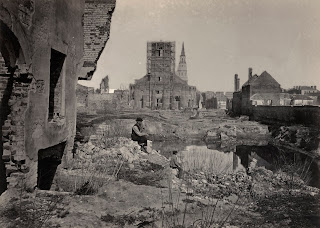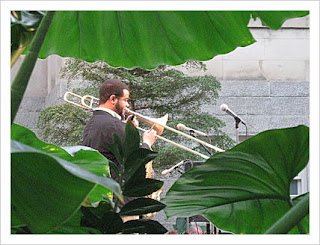 Luis Jimenez (1940-2006) born El Paso, TX , Man on Fire, 1969, made of fiberglass and acrylic urethane, and standing about 6.5 feet tall, opens the exhibition, "Our America: The Latino Presence in American Art." Gift of Philip Morris, Inc., Smithsonian American Art Museum/photo by Patricia Leslie
Luis Jimenez (1940-2006) born El Paso, TX , Man on Fire, 1969, made of fiberglass and acrylic urethane, and standing about 6.5 feet tall, opens the exhibition, "Our America: The Latino Presence in American Art." Gift of Philip Morris, Inc., Smithsonian American Art Museum/photo by Patricia LeslieOnly one day left to see a marvelous array of color, images and explosive art selected by E. Carmen Ramos, the curator of Latino art for the Smithsonian American Art Museum whose collection supplies the exhibition for "Our America: The Latino Presence in American Art" up through March 2 at the museum.
 Amalia Mesa-Bains, born Santa Clara, CA 1943, An Ofrenda for Dolores del Rio, 1984, rev. 1991. Museum purchase, Smithsonian American Art Museum. The label said Ms. Mesa-Bains made this memorial in honor of the famous Mexican actress (1905-1983)/photo by Patricia Leslie.
Amalia Mesa-Bains, born Santa Clara, CA 1943, An Ofrenda for Dolores del Rio, 1984, rev. 1991. Museum purchase, Smithsonian American Art Museum. The label said Ms. Mesa-Bains made this memorial in honor of the famous Mexican actress (1905-1983)/photo by Patricia Leslie.  Amalia Mesa-Bains, born Santa Clara, CA 1943, close-up of An Ofrenda for Dolores del Rio, 1984, rev. 1991. Museum purchase, Smithsonian American Art Museum/photo by Patricia Leslie
Amalia Mesa-Bains, born Santa Clara, CA 1943, close-up of An Ofrenda for Dolores del Rio, 1984, rev. 1991. Museum purchase, Smithsonian American Art Museum/photo by Patricia LeslieThe variety and subjects of past and present by 72 artists whose 92 pieces are included will astonish and amaze. Modern, abstract, stories, sound, film, photography, and sculpture are here for all to see.
 Melesio Casas, b. El Paso, TX 1929, Humanscape 62, 1970. Museum purchase, Smithsonian American Art Museum. The centerpiece of Casas' oil is the former mascot for Frito-Lay corn chips which Chicano activists successfully lobbied the company to remove, according to the label. Casas surrounds the mascot with "brown" objects meant to critique "rich cultures" which stereotype Chicanos.
Melesio Casas, b. El Paso, TX 1929, Humanscape 62, 1970. Museum purchase, Smithsonian American Art Museum. The centerpiece of Casas' oil is the former mascot for Frito-Lay corn chips which Chicano activists successfully lobbied the company to remove, according to the label. Casas surrounds the mascot with "brown" objects meant to critique "rich cultures" which stereotype Chicanos. The presentation advances the Smithsonian's goal "to build a significant collection of Latino art," said Elizabeth Broun, the museum's director, in a statement. The effort took three years to put together, and the outcome "truly represents the Latino experience in this country," she said.
 Pepon Osorio, born Santurce, Puerto Rico, 1955, El Chandelier, 1988. Museum purchase, Smithsonian American Art Museum. According to the label, the inspiration behind this work came from "elaborate chandeliers hanging in humble apartment homes" which the artist saw while working as a social worker in New York City/photo by Patricia Leslie
Pepon Osorio, born Santurce, Puerto Rico, 1955, El Chandelier, 1988. Museum purchase, Smithsonian American Art Museum. According to the label, the inspiration behind this work came from "elaborate chandeliers hanging in humble apartment homes" which the artist saw while working as a social worker in New York City/photo by Patricia LeslieIf you miss the show in Washington, you may still see it in other U.S. cities since it travels to Florida International University in Miami for exhibition from March 28 - June 22, 2014; the Crocker Art Museum in Sacramento, CA, Sept. 21, 2014 - Jan. 11, 2015; the Utah Museum of Fine Arts, Salt Lake City, Feb. 6, - May 17, 2015; the Arkansas Art Center in Little Rock, Oct. 16, 2015 - Jan. 17, 2016; and the Delaware Art Museum in Wilmington, March 5 - May 29, 2016.
 Arturo Rodriguez, born Ranchuelo, Cuba, 1956, Sin Titulo, from the series, "The Tempest." Gift of Liza and Pedro J. Martinez-Fraga, Smithsonian American Art Museum. The label copy said Giorgione's The Tempest (c. 1505).was the inspiration for this painting.
Arturo Rodriguez, born Ranchuelo, Cuba, 1956, Sin Titulo, from the series, "The Tempest." Gift of Liza and Pedro J. Martinez-Fraga, Smithsonian American Art Museum. The label copy said Giorgione's The Tempest (c. 1505).was the inspiration for this painting. Ester Hernandez, born Dinuba, CA 1944, Sun Mad, 1982. Gift of Tomas Ybarra-Frausto, Smithsonian American Art Museum
Ester Hernandez, born Dinuba, CA 1944, Sun Mad, 1982. Gift of Tomas Ybarra-Frausto, Smithsonian American Art MuseumWhat: Our America: The Latino Presence in American Art
When: Closes Sunday, March 2, 2014. The museum is open from 11:30 a.m. - 7 p.m. Sunday.
Where: Smithsonian American Art Museum, 8th and F streets, N. W., Washington, D.C.
How much: No charge
For more information: 202-633-1000 or visit the web site
Metro station: Gallery Place-Chinatown or walk 10 minutes from Metro Center
patricialesli@gmail.com









 George N. Barnard, Ruins In Charleston, South Carolina, 1865, The Nelson-Atkins Museum of Art, Kansas City, Missouri. Gift of Hallmark Cards, Inc./Michael Lamy
George N. Barnard, Ruins In Charleston, South Carolina, 1865, The Nelson-Atkins Museum of Art, Kansas City, Missouri. Gift of Hallmark Cards, Inc./Michael Lamy





.jpg)






